Disclaimer: Asian Century Stocks uses information sources believed to be reliable, but their accuracy cannot be guaranteed. The information contained in this publication is not intended to constitute individual investment advice and is not designed to meet your personal financial situation. The opinions expressed in such publications are those of the publisher and are subject to change without notice. You are advised to discuss your investment options with your financial advisers. Consult your financial adviser to understand whether any investment is suitable for your specific needs. I may, from time to time, have positions in the securities covered in the articles on this website. This is not a recommendation to buy or sell stocks.
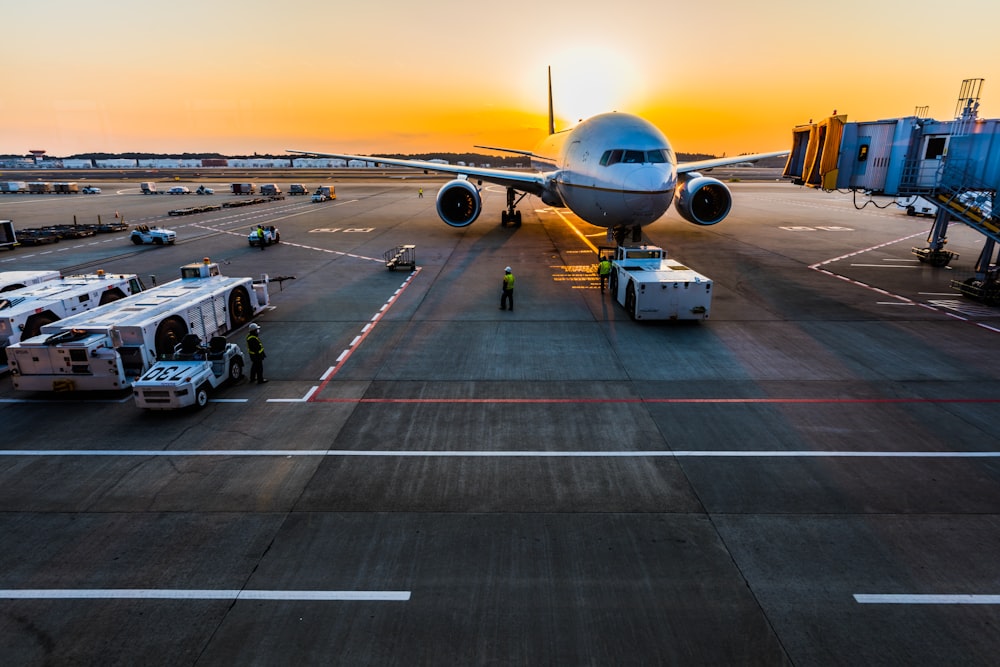
China will open up its borders on 8 January 2023. This comes after almost three years of total isolation from the world and will have major ramifications in Asia and beyond.
Summary
- As I wrote in early December, China’s policy of “dynamic zero-COVID” has turned into “dynamic let it rip”. In other words, the Chinese government is letting COVID-19 spread without much control.
- The peak in the current COVID-19 wave in China will probably occur sometime in the next few weeks.
- I expect a large increase in cross-provincial travel during late January’s Spring Festival and outbound tourism from China’s border reopening on 8 January 2023.
- Companies benefitting from outbound Chinese tourism include Asian hotels, airports, casinos, online travel agents, duty-free stores, and tour operators.
1. A timeline of easing restrictions
Since early 2020, Chinese outbound tourism has been almost non-existent:
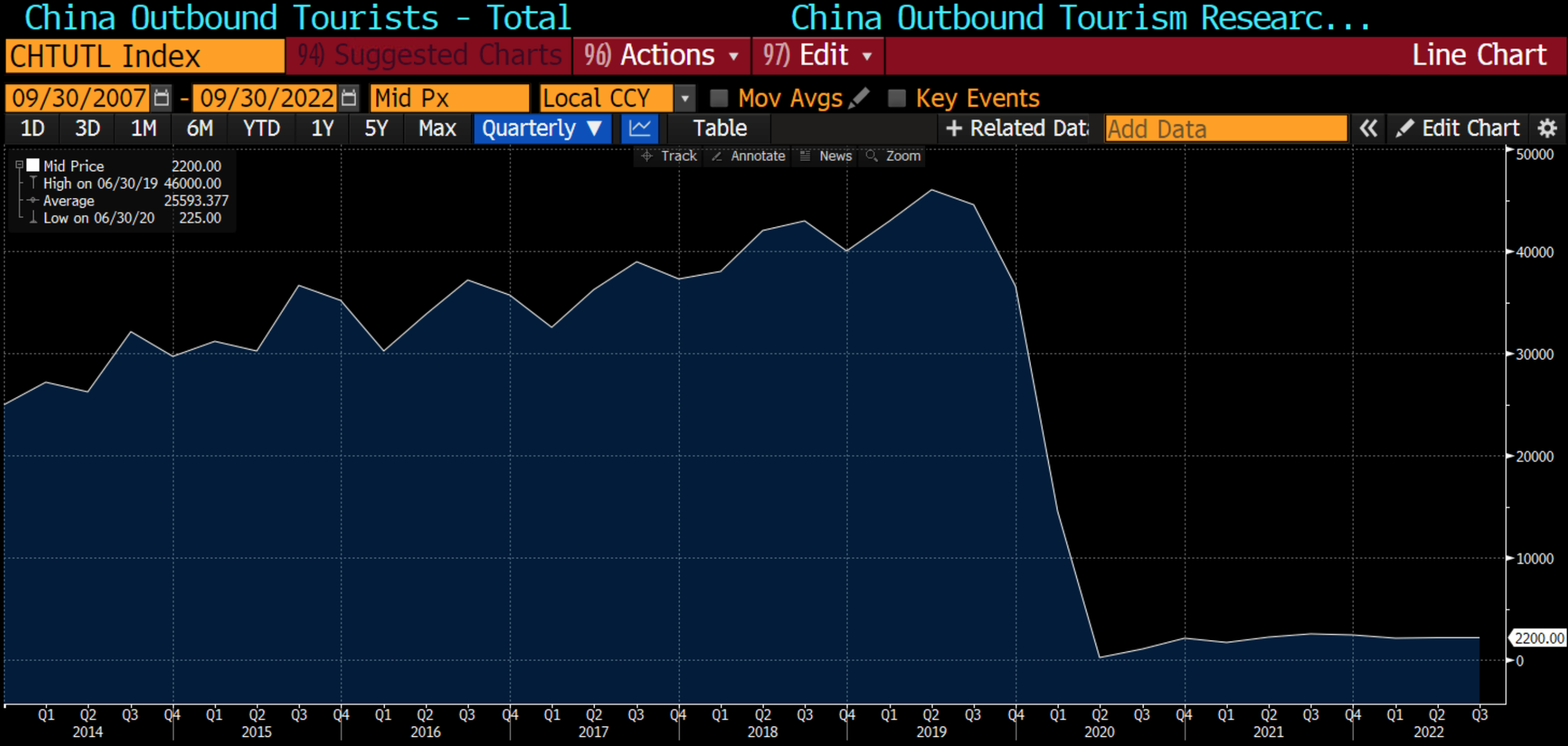
The primary hurdles for travel have been government regulation when it comes to quarantine and passport issuance.
But in the past three months, we’ve seen gradual signs of loosening in China’s zero-COVID policy. Here’s the timeline from September 2022 onwards:
- 26 September 2022: In September, the Hong Kong government removed its hotel quarantine requirements. Instead, inbound travellers just had to do 3 days of health monitoring and COVID-19 tests until day 7 after arrival. Many investors speculated that this presaged a similar opening in mainland China.
- 11 November 2022: China’s National Health Commission announced a document now known as The 20 Measures. The government stopped tracing close contacts and started to discourage lockdowns at the local level. The required hotel quarantine was reduced from 7 days to 5 days, plus a home quarantine of 3 days. Airlines no longer faced a penalty if the number of COVID positive patients exceeded a certain number.
- 7 December 2022: PCR mass testing was stopped outside of high-risk areas, including for cross-provincial travel. Home quarantine was allowed for asymptomatic and mild COVID cases. The health pass app was no longer needed for entry to public spaces. The flight suspension mechanism was also removed.
- 25 December 2022: In late December, the Chinese government stopped releasing statistics on asymptomatic COVID cases, presumably to assuage fears about COVID-19 among the population.
- 8 January 2023: Finally, on 8 January, the Chinese government will remove all quarantine requirements for inbound travellers. The only requirement is that travellers need a PCR test 48 hours before departure. The government also confirmed that passport issuance would resume on 8 January. The National Health Commission said in an announcement that Chinese citizens’ ability to travel overseas would be “resumed in an orderly manner”. And at the same time, Hong Kong will also introduce quarantine-free travel for mainland Chinese visitors on 8 January, and post-arrival tests will no longer be needed.
The main takeaway is that from 8 January, both cross-provincial and international travel will have resumed, with the only requirement being a PCR test before departure.
2. Willingness to travel
In my view, mainland Chinese are dying to travel again after three years of isolation. The revenge travel phenomenon is real.
According to a recent survey conducted by marketing agency Dragon Trail International, more than 1/3 of respondents said they would travel outside of mainland China within six months of travel restrictions being lifted:
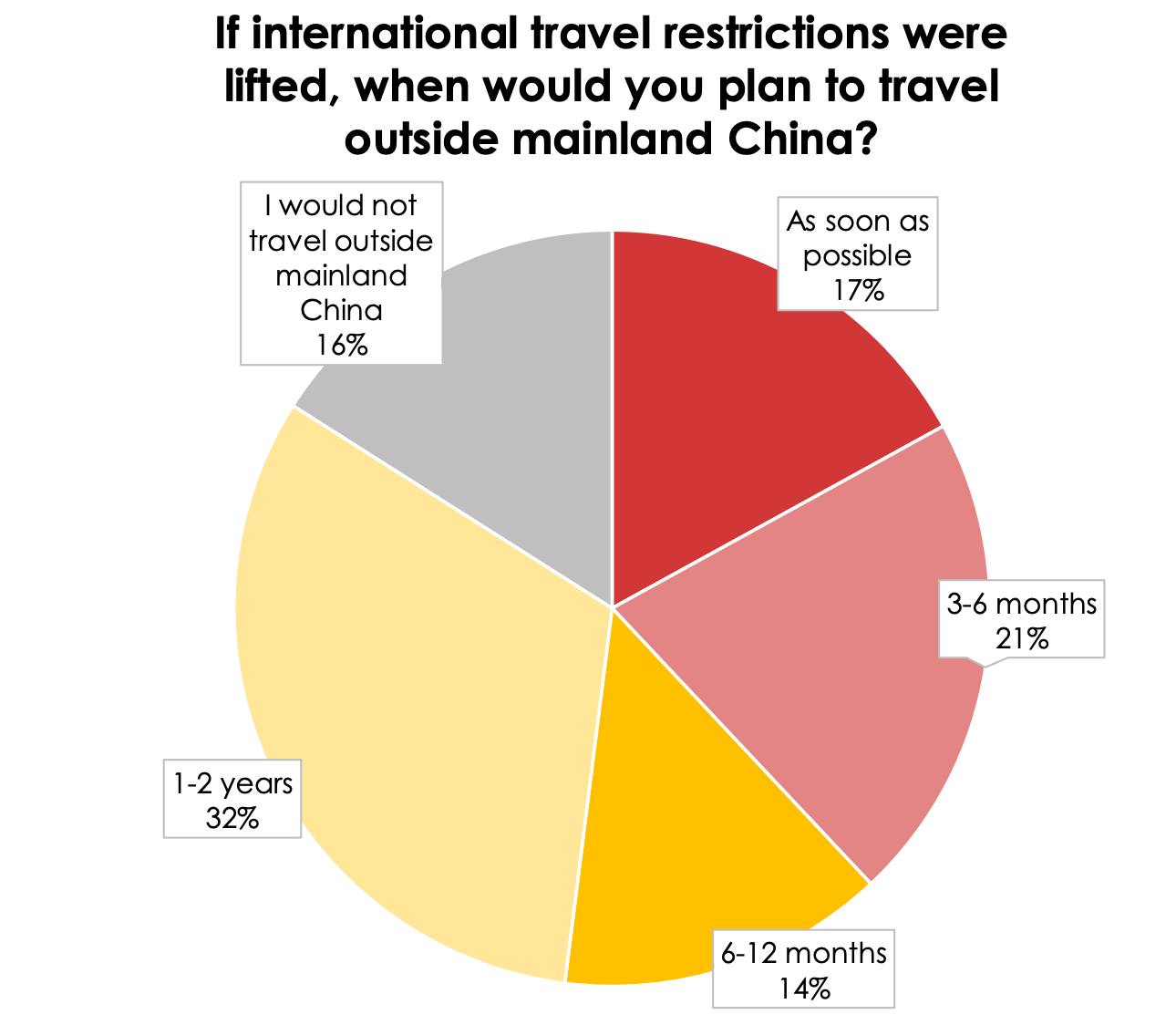
Where will they go? The most popular Chinese travel destinations have historically been Japan, South Korea, Thailand and Singapore, according to this 2019 Weixin report:

But in late 2022, according to the above Dragon Trail’s survey, Hong Kong is now at the top of the list, followed by Japan.
3. Early signs of a tourism recovery
When it comes to the spread of COVID-19, China’s reported infection numbers reached a peak on 2 December:
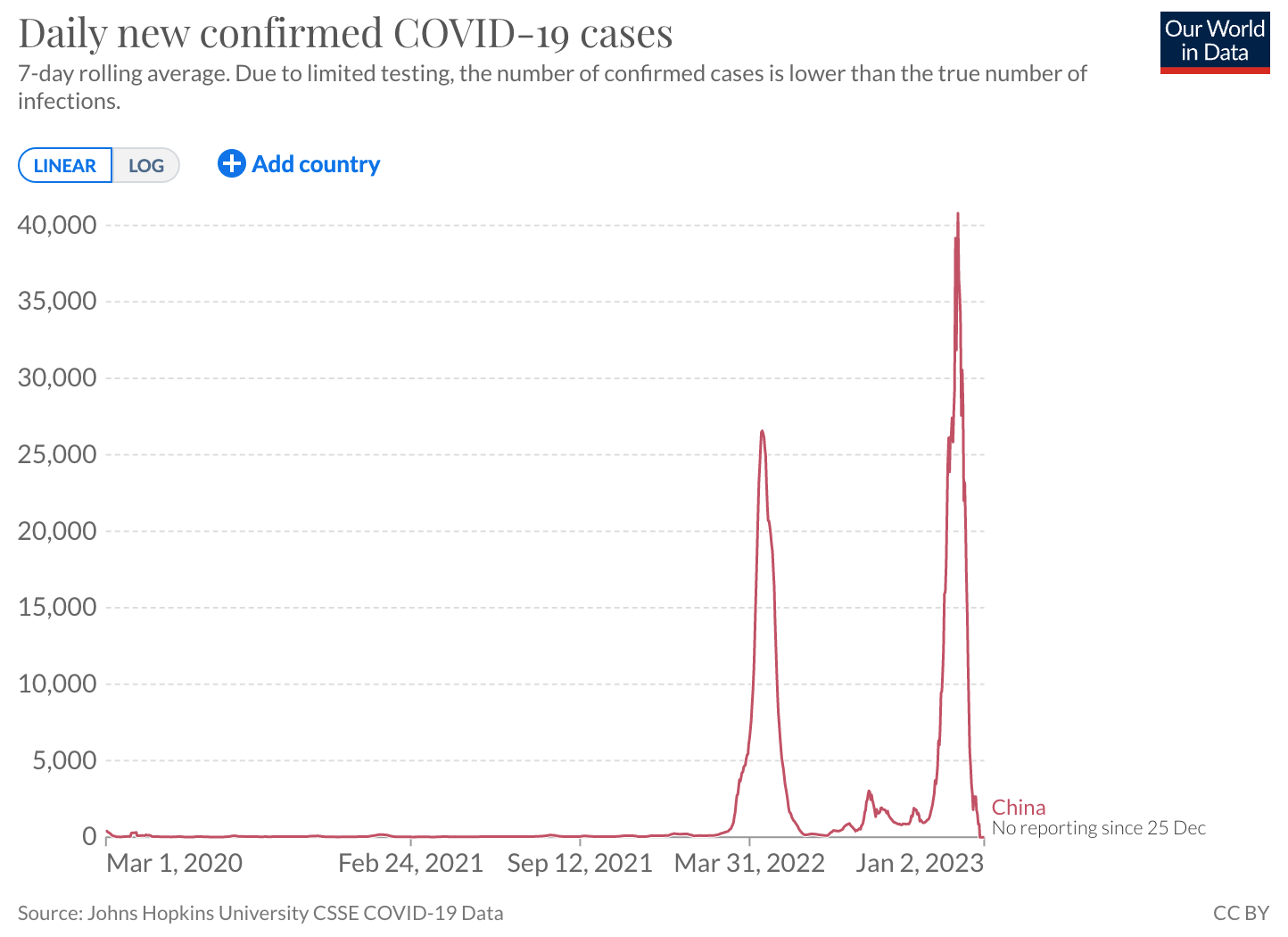
But since mass testing has been removed and asymptomatic cases are no longer reported, these numbers no longer tell us much about the pandemic.
According to Baidu search query data, the city of Beijing had already passed the infection peak in mid-December, with 30% of the population infected. A doctor in Shanghai said in early January that 70% of the city’s population had already been infected. And according to a Chinese research team quoted by Global Times, small- and medium-sized cities will see a peak in their outbreaks sometime between 1 January and the Spring Festival on 22 January. So it looks like we’re now very close to peak COVID-19 in China.
Transport data are showing early signs of recovery. For example, Beijing and Guangzhou’s subway traffic improved materially in the last week of December. Shanghai and Nanjing are getting closer to that point as well. I believe the ridership in most tier 1/2 city metro systems will recover in the next week or two.
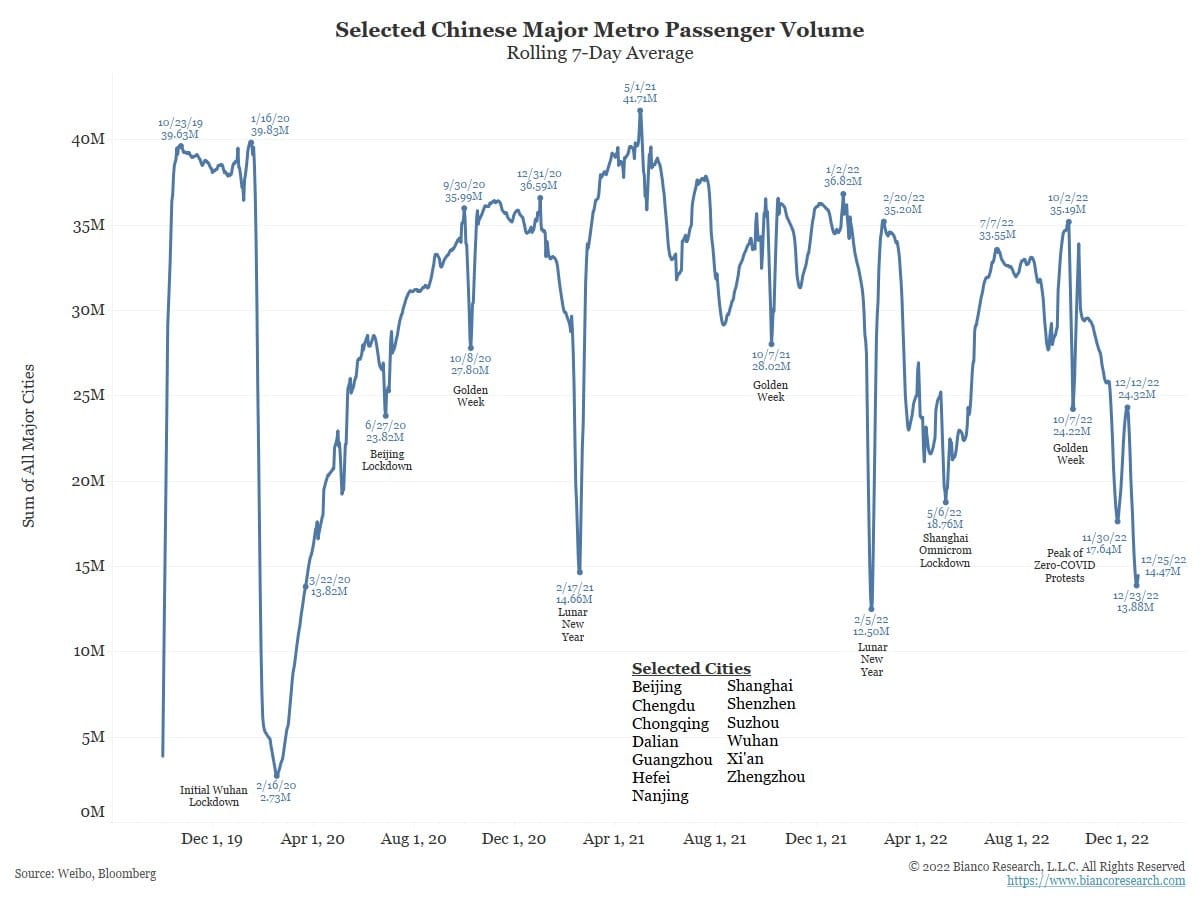
Regarding cross-provincial travel, there are signs that air travel search query volumes were up significantly in late December 2022.
When China’s cross-provincial travel restrictions were removed on 7 December, Ctrip’s search query volumes shot up, almost immediately reaching 76% of the 2019 baseline vs about 50% previously.
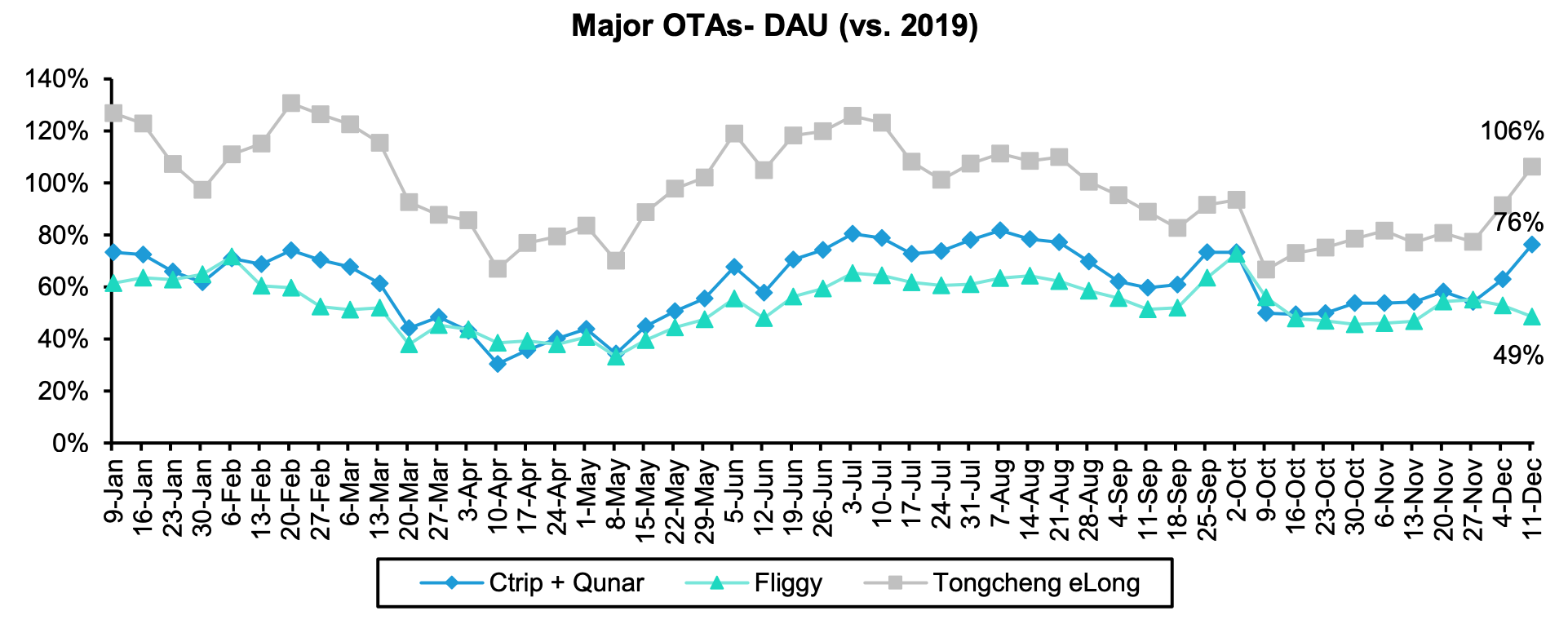
Sanya hotel prices have recovered to pre-pandemic levels, and that’s another sign that cross-provincial travel is recovering well:
@Josh_Young_1 Also re. air travel, can't find reporting in English, but local news reporting Sanya hotels running full prices (was 50% off just a wk ago), air travel search volume up 160%, bookings up 30~75%, flights scheduled now above last week. Air travel is in full BURST recovery mode.
— Namniko (@xxxx_chen) 4:42 AM ∙ Dec 26, 2022
Cross-provincial travel will be massive during the Spring Festival in late January. Many haven’t visited their hometowns in three years.
The Hong Kong experience since it eased its quarantine requirements back in September may serve as a precedent for what will happen in mainland China. By mid-December, Hong Kong airport arrivals had recovered to 20% of the pre-pandemic / pre-protest level.

Hong Kong’s inbound tourism - the green and turquoise lines in the chart above - remained weak until December. But I believe that removing Hong Kong’s post-arrival testing requirements will finally lure foreign tourists to come back to Hong Kong.
Another positive sign is that Chinese airlines are gearing up for greater international travel. The number of scheduled international flights is now back to about 7% of the pre-COVID level and going up steadily.
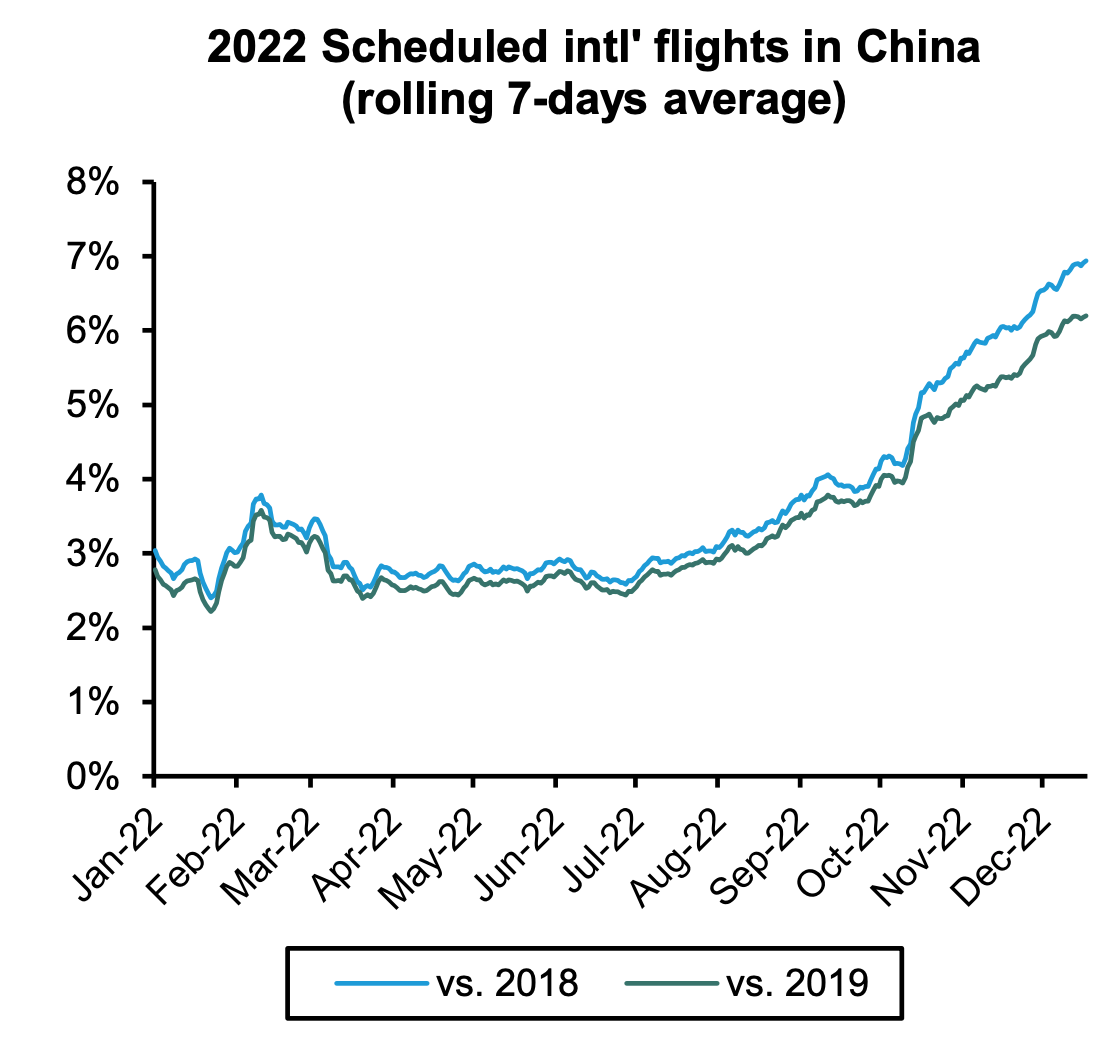
A headwind for outbound travel is the rising number of restrictions from destination countries. By late December 2022, we’ve seen five separate countries restricting visitors from mainland China: Japan, India, Taiwan, Italy and the United States.
Another hurdle is that mask-wearing is still required in public places in both mainland China and Hong Kong. But I would imagine those restrictions will ease in the next few months as well.
Finally, a major worry has been whether new, more severe variants might have popped up in China. There’s anecdotal evidence of patients in China suffering from breathing issues, with their CT scans showing lung inflammation.
- One explanation for such “white lungs” is that these individuals caught the original Wuhan strain - which caused lung inflammation - but didn’t do proper CT scans until now.
- Another explanation is that China’s Sinovac shots haven’t protected as well against Omicron as mRNA vaccines did in other countries.
- Lastly, some foreign governments worry that the white lungs are related to a new variant that could eventually spread to the rest of the world. The speed at which COVID-19 is spreading in China does suggest a variant with a higher reproduction rate than prior Omicron variants.

In any case, WHO met with Chinese officials in late December and has asked the National Health Commission to share sequencing data to ensure that it is indeed Omicron that spreading in China and not some newer, more problematic variant. The sequencing data retrieved so far suggests that there is no new variant.
I personally believe that the white lungs are from individuals previously infected with the original Wuhan strain. Nothing to be too worried about.









